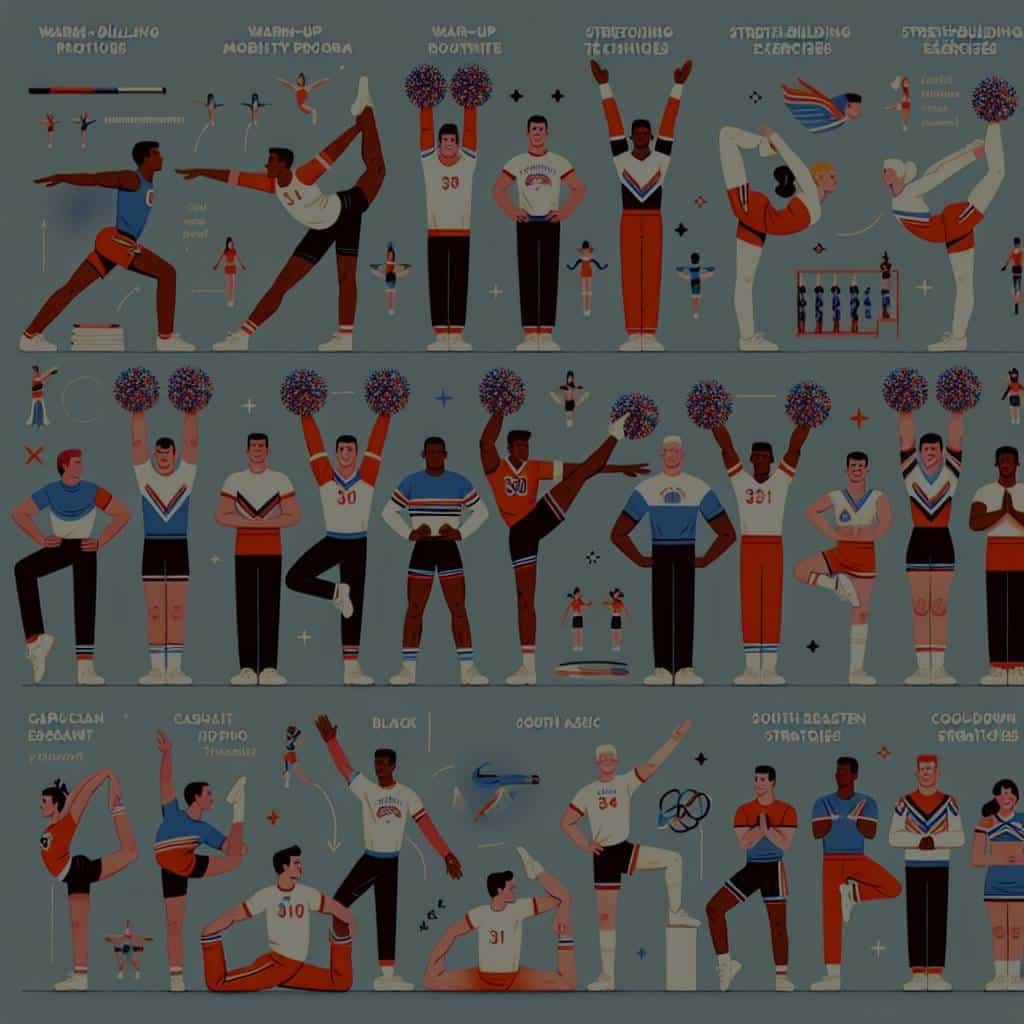How to Structure a Flexibility and Mobility Program for Competitive Cheerleaders?

Flexibility and mobility are essential elements of any successful cheerleader’s skill set. These traits can help cheerleaders perform stunts and routines effortlessly while reducing the risk of injuries. But how does one go about designing a program that improves flexibility and promotes better mobility? This comprehensive guide will walk you through the process.
Understanding the Importance of Flexibility
Before diving into the creation of a flexibility training program, it is crucial to understand the importance of this attribute in cheerleading.
Also read : What Are the Advantages of Isokinetic Strength Training for Shot Put Athletes?
Flexibility refers to the range of motion in a joint or group of joints. In cheerleading, it allows for the execution of high kicks, jumps, splits, and other complex movements. Being flexible can also help cheerleaders recover quicker from muscle soreness and reduce the probability of injuries.
Improving flexibility goes beyond the simple act of stretching. It takes time and consistent, targeted effort. Regular flexibility exercises can help athletes increase their range of motion over time, enhancing their overall performance and competitive edge.
In the same genre : What Are the Best Strategies for Teaching Effective Communication Skills in Doubles Tennis?
Key Components of a Flexibility Program
A well-structured flexibility program for cheerleaders consists of several components, each designed to target specific areas of the body and improve overall performance.
Firstly, the program must include dynamic stretching exercises. These are movements performed in a controlled, smooth, and deliberate manner. They are typically done before a workout to warm up the muscles and improve joint mobility.
Secondly, static stretching should be included in the program. Unlike dynamic stretching, static stretches are done after a workout and involve holding a specific position for a certain amount of time to increase the muscle’s length.
Thirdly, the program should incorporate strength training exercises. Contrary to some beliefs, strength training doesn’t hinder flexibility; in fact, it can enhance it. Strength training helps by improving muscle balance around the joints, leading to better flexibility.
Lastly, your program should focus on maintaining proper hip mobility. The hip is a critical area for cheerleaders, as it is involved in most cheerleading movements, such as jumps, kicks, and splits.
Designing a Cheerfit Program
A CheerFit program combines traditional cheerleading skills with fitness training, providing a comprehensive workout for cheer athletes.
Start off by incorporating warm-up routines that focus on the body parts most utilized in cheerleading: the shoulders, hips, and legs. Then, move on to strength training exercises, focusing on the core, as it plays a significant role in maintaining body balance during stunts and routines.
Next, introduce flexibility exercises, such as deep lunges, leg stretches, and hamstring stretches. Remember, these exercises need to be specific to the movements performed in cheerleading to be effective.
Lastly, don’t forget to include cool-down exercises. These help to slowly lower the heart rate and relax the muscles, reducing post-workout soreness and aiding in recovery.
Implementing the Program
Once you have your CheerFit program designed, the next step is implementation. This is where will comes into play. Consistency is key when it comes to improving flexibility and mobility.
Try to implement your program at least three times a week. Start slowly, gradually increasing the intensity of the workouts as your strength and flexibility improve. Ensure that the athletes are performing the exercises correctly to avoid injury and achieve the best results.
Remember to vary the exercises regularly, to keep the workouts interesting and challenge different muscle groups. Also, encourage your cheerleaders to communicate any discomfort, fatigue, or pain they may be experiencing during the workouts. This information can help you adjust the program to better suit their needs and prevent injuries.
Monitoring Progress and Adjustments
The final aspect of structuring a flexibility and mobility program involves monitoring progress and making necessary adjustments.
Progress can be tracked in several ways, such as measuring the range of motion in certain joints, testing for strength improvements, or visually assessing the execution of specific cheerleading skills.
If progress is slower than expected, adjustments may need to be made. Perhaps more focus needs to be placed on specific muscle groups, or maybe the intensity of the workouts needs to be increased. On the other hand, if an athlete is experiencing repeated discomfort or injuries, the program may need to be scaled back.
A well-structured flexibility and mobility program can significantly improve a cheerleader’s performance and reduce the risk of injury. It requires careful planning, consistent implementation, and regular adjustment. However, with time and effort, the benefits to the athletes’ performance and overall health are well worth the investment.
Evaluating the Key Areas of Focus
A successful flexibility training strategy will address the particular needs and demands of cheerleading. This involves focusing on the dominant areas of the body involved in the sport: the hip flexor, area core, and the legs.
The hip flexor is a group of muscles in the hip region that plays an essential role in facilitating high kicks, jumps, and splits. Hence, maintaining good hip mobility is vital in a cheerleading flexibility program. Useful exercises for the hip flexor include lunges, leg swings, and hip circles.
The area core (abdomen, lower back, and pelvic muscles) is fundamental for cheerleaders. It offers stability, balance, and strength needed to perform complex stunts and routines. Core exercises such as planks, bridges, and abdominal crunches can be incorporated into the program to enhance strength and stability.
Lastly, leg flexibility is crucial in cheerleading for high kicks, jumps, and splits. Exercises such as hamstring stretches and calf raises can help improve flexibility in this area.
Danielle Donovan, a renowned cheerleading coach and fit mom, emphasizes the importance of these focus areas in her flexibility makeover program. She underscores the need to incorporate exercises that target these areas into any comprehensive cheerleading flexibility and mobility program.
The Role of Strength Conditioning
While flexibility training is crucial for cheerleaders, it should not overshadow the importance of strength conditioning. Strength training can help cheerleaders enhance their flexibility, improve their performance, and reduce injury risk.
Strength conditioning exercises like squats, lunges, and push-ups can help build muscle strength and endurance. This in turn will help cheerleaders maintain balance, execute stunts more efficiently, and recover faster from workouts.
According to a study published on NCBI NLM NIH, incorporating strength training into a flexibility program can enhance joint stability and increase the range of motion. This will help cheerleaders perform more challenging routines with ease and confidence.
However, strength training should be done carefully and progressively to avoid injury. It’s advised to start with light exercises and gradually increase intensity as the cheerleader’s strength improves.
Conclusion: The Journey to Complete Flexibility
Designing and implementing a flexibility and mobility program for competitive cheerleaders is not a simple task, but it’s not impossible with the right knowledge and guidance. The key is understanding the importance of flexibility and mobility in cheerleading, identifying the focus areas, and incorporating the right exercises.
The program should be comprehensive, targeting all the essential areas such as the hip flexor, core area, and legs. It should include both flexibility and strength training exercises to offer the best results. Danielle Donovan’s flexibility makeover program is an awesome label that provides a sneak peek into what a well-rounded cheerfit program should look like.
Regular implementation of the program, at least thrice a week, is crucial for its success. Encouraging open communication between the cheerleaders and the coach will help monitor progress and make necessary adjustments to the program. The fit tips provided by experts can also be beneficial in this journey towards complete flexibility.
Remember, this is not an overnight process. It needs time, consistent effort, and will. But with perseverance and dedication, the cheerleaders can achieve improved performance, reduced injury risk, and an enhanced range of motion. The journey to complete flexibility is indeed an exciting one, which, when done right, leads to not just better performance but also a healthier, stronger body.
